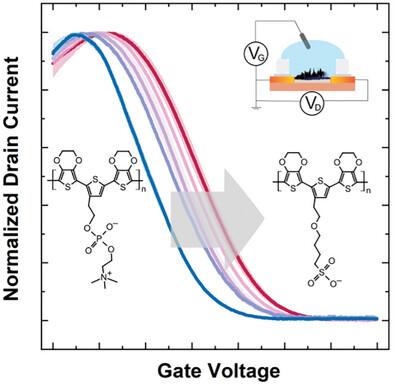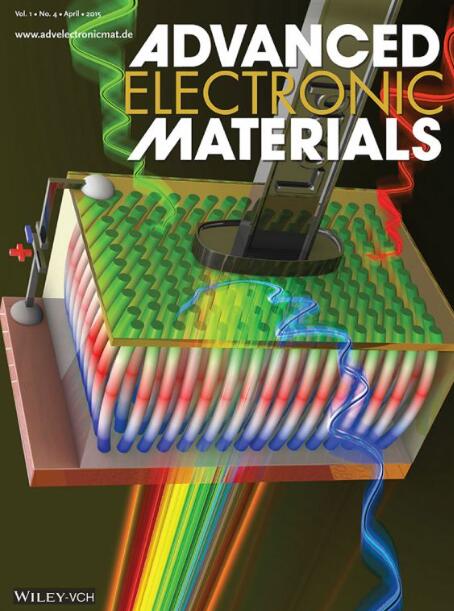Tuning the Organic Electrochemical Transistor (OECT) Threshold Voltage with Monomer Blends
IF 5.3
2区 材料科学
Q2 MATERIALS SCIENCE, MULTIDISCIPLINARY
引用次数: 0
Abstract
A novel approach is introduced to modulate the threshold voltage of organic electrochemical transistors (OECTs) that are fabricated by electropolymerizing the channel material between the source and drain electrodes. To achieve this, we adjust the ratio of two water‐soluble tri‐thiophene monomers, which share the same backbone, but present either anionic or zwitterionic sidechains, during channel formation. This approach allows for a continuous modulation of both the electropolymerization onset potential and the native doping state of the film. We attribute the effect of monomer blends displaying properties that are a weighted average of their components to the formation of nanoscale monomer aggregates that have a uniform internal charge density. Through an investigation of monomer aggregation behavior, polymer film growth, and device properties of OECTs fabricated by electropolymerization, we highlight the importance of monomer aggregation in the electropolymerization of conducting polymers. The ability to tune both electropolymerization onset and the OECT threshold voltage has significant implications for the development of more complex circuits for integrated neuromorphic computing, biosensing, and bioelectronic systems.

用单体混合物调节有机电化学晶体管 (OECT) 的阈值电压
本文介绍了一种调节有机电化学晶体管(OECT)阈值电压的新方法,这种晶体管是通过电聚合源极和漏极之间的沟道材料制造而成的。为此,我们在沟道形成过程中调整了两种水溶性三噻吩单体的比例,这两种单体具有相同的骨架,但呈现阴离子或齐聚离子侧链。这种方法可以持续调节电聚合起始电位和薄膜的原生掺杂状态。我们认为,单体混合物所显示的特性是其各组分的加权平均值,而这种特性的产生则是由于形成了具有均匀内部电荷密度的纳米级单体聚集体。通过对单体聚集行为、聚合物薄膜生长以及电聚合制造的 OECTs 器件特性的研究,我们强调了单体聚集在导电聚合物电聚合过程中的重要性。调整电聚合起始和 OECT 阈值电压的能力对于开发用于集成神经形态计算、生物传感和生物电子系统的更复杂电路具有重要意义。
本文章由计算机程序翻译,如有差异,请以英文原文为准。
求助全文
约1分钟内获得全文
求助全文
来源期刊

Advanced Electronic Materials
NANOSCIENCE & NANOTECHNOLOGYMATERIALS SCIE-MATERIALS SCIENCE, MULTIDISCIPLINARY
CiteScore
11.00
自引率
3.20%
发文量
433
期刊介绍:
Advanced Electronic Materials is an interdisciplinary forum for peer-reviewed, high-quality, high-impact research in the fields of materials science, physics, and engineering of electronic and magnetic materials. It includes research on physics and physical properties of electronic and magnetic materials, spintronics, electronics, device physics and engineering, micro- and nano-electromechanical systems, and organic electronics, in addition to fundamental research.
 求助内容:
求助内容: 应助结果提醒方式:
应助结果提醒方式:


